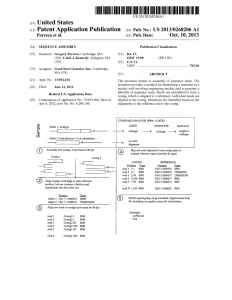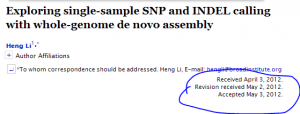
Ex-student of George Church Invents Genome Assembly from Short Reads !!
It doesn’t look like a very Good Start.

Patent application title: SEQUENCE ASSEMBLY
Inventors: Gregory Porreca (Cambridge, MA, US) Gregory Porreca (Cambridge, MA, US) Caleb J. Kennedy (Arlington, MA, US)
Assignees: GOOD START GENETICS, INC.
IPC8 Class:
USPC Class: 702 20
Class name: Measurement system in a specific environment biological or biochemical gene sequence determination
Publication date: 2013-10-10
Patent application number: 20130268206
Abstract:
The invention relates to assembly of sequence reads. The invention provides a method for identifying a mutation in a nucleic acid involving sequencing nucleic acid to generate a plurality of sequence reads. Reads are assembled to form a contig, which is aligned to a reference. Individual reads are aligned to the contig. Mutations are identified based on the alignments to the reference and to the contig.
Claims:
1. A method for identifying a mutation in a nucleic acid, the method comprising: sequencing nucleic acid to generate a plurality of sequence reads; creating a contig based on the reads; aligning the contig to a reference sequence; aligning the individual reads back to the contig; and identifying a mutation based on the alignments to the contig and the reference sequence.
2-12. (canceled)
13. A system for identifying a mutation in a nucleic acid, the system comprising: a computing device including a tangible, non-transitory memory coupled to a processor configured to execute computer program instructions to cause the processor to: receive a plurality of sequence reads; create a contig based on the reads; align the contig to a reference sequence; align the individual reads back to the contig; and identify a mutation based on the alignments to the contig and the reference sequence.
14. The system of claim 13, wherein the computing device is further configured to divide the reads into subsets.
15. The system of claim 13, wherein the computing device is further configured to determine a position of the mutation in the nucleic acid.
16. The system of claim 13, wherein the mutation is selected from the group consisting of: a single nucleotide polymorphism (SNP), an insertion, a deletion, a substitution, a translocation, and a copy number variation.
17. The system of claim 13, wherein the computing device is configured to identify a plurality of mutations.
18. The system of claim 17, wherein a first mutation is within about 100 nucleotides of a second mutation.
19. The system according to claim 18, wherein the first mutation is a substitution and the second mutation is a deletion.
20. The system of claim 13 wherein the mutation is a deletion at an end of a sequence read.
21. The system of claim 13, wherein the mutation is associated with a disease.
22. The system according to claim 13, wherein the reads are produced by sequencing-by-synthesis.
23. The system according to claim 22, wherein sequencing-by-synthesis is single molecule sequencing-by-synthesis.

About the genius inventor -

Greg is an expert developer of genome analysis technology and has served as a Lecturer on Genetics at Harvard Medical School as well as the Personal Genome Project Director of Technology. During that time, he co-developed the Polonator, a high-throughput commercial DNA sequencing system, in collaboration with Danaher Motion Dover. Greg also co-developed one of the first next-generation DNA sequencing systems at Harvard, which was further developed by Applied Biosystems to become the SOLiD platform. He is a featured author in numerous prestigious publications, an inventor on multiple patents/applications for nucleic acid analysis and has consulted for sequencing-related biotech companies. Greg is a Founder of Good Start Genetics. He holds a Ph.D. in Genetics from Harvard University and a B.S. in Computer Science and Biology from The College of New Jersey.
-———————-
Not invented here -

